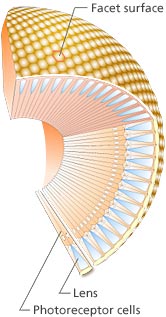Butterflies have only 0.04 the visual acuity of humans. How is it that a butterfly, with barely the vision to see a small coin at a distance of 50 cm, can accurately extend its straw-like mouth to flower nectar guides less than 1 mm in diameter? The butterfly’s ability to perceive color has evolved in a surprising way.
Psyche—the princess named after the butterfly

Psyche and the god Eros
© Giraudon/Superstock/PPS
The Greek word for butterfly is “psyche,” which in Greek mythology is the name of a beautiful princess and wife of the god Eros.
Psyche, a mortal, was forbidden to look at her husband. However, consumed by fear that her husband may be a hideous monster, she steals a look at him as he lies sleeping beside her, only to discover that he is a handsome god.
Psyche then overcomes numerous hardships in her pursuit of Eros, but in the end is reunited with him and admitted to the pantheon of the gods. After becoming an immortal, Psyche sprouts beautiful butterfly wings.
The experiences of Psyche make her a model for lovers—the key to love is not to keep a jealous eye on your partner, but to trust him or her with all your heart.
Amusingly, the butterfly is known to keep its mate under “close watch.” An area on the creature’s rear end is light-sensitive, and by sensing light, a butterfly can check that it is coupled with its mate so that its eggs can be fertilized. Kentaro Arikawa, Professor at the Graduate University for Advanced Studies, discovered this fact while still a graduate student. According to Professor Arikawa, butterflies see the world in much richer color than humans do.
The eye of a butterfly

The eye of the swallowtail butterfly. The eye is comprised of approximately 12,000 individual facets.
What kind of world do other living creatures see? Do they perceive the world as we do? Researchers have long sought answers to these questions.
For example, the honeybee cannot see the color red. Insects live in a world of green, and can therefore survive without the ability to distinguish red—a color that is far different from green.
How then do butterflies find flowers? The nymphalid butterfly can only see green. However, if the swallowtail, which is common in Japan, is repeatedly offered nectar on red paper, it is trained to remember the color and will return again and again to the red paper. Red is therefore visible to the swallowtail. Until recently, however, the mechanism behind this was unknown.
The structure of a butterfly’s eye is very different from that of a human eye. The butterfly has a compound eye comprised of many facets—in the case of the swallowtail, each of its eyes consists of an incredible 12,000 facets. The different facets do not of course see a different view of the world—rather, like the pixels of a digital camera, the facets collectively perceive a single view of the world.
As viewed externally, the facets all appear identical. However, they possess an astounding individuality, which accounts for why the butterfly can see the world in such rich color.
The six basic color elements
Humans can distinguish the so-called primary colors of light (red, green, and blue) allowing us to see various colors. But how many colors can the butterfly distinguish? Scientists have been able to examine the facets of a swallowtail’s eye by inserting electrodes into them. What has been discovered is that the swallowtail can distinguish as many as six color elements (ultraviolet, purple, blue, green, red, and the wideband light from red to purple). It has the ability to see a world of rich colors and, most notably, it can discern ultraviolet light, unlike humans. In fact, many flowers have an area close to where their nectar is that absorbs ultraviolet light. It is not hard to see why it is extremely important for a butterfly to be able to see ultraviolet in order to identify the location of nectar.
What is surprising, however, is that individually the facets are not able to perceive all six color elements. It was found that each facet can see several color elements. This was a remarkable discovery, as it had been believed that all the facets were identical.
It has been found that a single facet of a swallowtail’s eye is comprised of nine cells, as shown in the diagram below. The size of each cell varies according to its depth below the surface of the facet. Seen in cross-section, they appear as beautiful as flowers. The six color elements are perceived using these nine cells.
Light which has entered through the surface of the facet passes down the cylindrical rhabdome that extends through the middle of the facet. As the light passes down the rhabdome, the cells surrounding the rhabdome absorb the light and perceive the color. In other words, each of the nine cells from the top to the bottom of the facet senses a different color.
As adjacent facets are identical in structure, they were thought to see the same color. However, experiments have shown that adjacent facets have different properties. Why is it that they differ?

Cross-section of the dyed facets of a swallowtail’s eye. The individual facets resemble flowers.

The facet and its cells from 1 to 9. Light enters through the surface of the facet and passes down through the central rhabdome.
The colored spectacles of the swallowtail
The breakthrough came after a discovery by Professor Arikawa and his team in 1997: the facets possess individual characteristics.
When viewed externally, the eye of the swallowtail appears to be black. However, light that passes down the facet’s rhabdome and is reflected back from the bottom will travel back up the rhabdome and emerge from the eye. Examining this light, known as “eye shine,” reveals which colors are absorbed by the eye. It was discovered that the swallowtail’s eye shine varies from facet to facet, and that there are three kinds of colors: deep pink, pale pink, and yellow.
The facet’s color varies according to the color of the pigment surrounding its rhabdome, which can be either red, pale pink (red and fluorescent), or yellow. All facets have the same structure. Thus, the facets of varied characteristics can be said to be created by the wearing of three different colored spectacles.
The function of the pigment is to absorb the light of different colors before the light passing through the rhabdome is absorbed by the cells. Facets of different pigmentation perceive different colors. For example, a pale pink facet recognizes purple, while a yellow facet identifies green.
The clever thing is that the cells that enclose the rhabdome recognize different colors according to their depth below the surface of the facet. While cells that are close to the surface of a red facet recognize ultraviolet light, cells that are deeper recognize red, since light is gradually absorbed as it passes down the rhabdome.
With the three different facets, the swallowtail thus has the ability to recognize six color elements. Its so-called colored spectacles (in the shape of the pigment) enable it to see a world rich in color.
Incidentally, it was British physician and physicist Thomas Young, who, in the 19th century, identified the fact that the human eye’s perception was based on the so-called three primary colors. Can the swallowtail then really have the ability to distinguish six color elements based on the six primary colors?
Professor Arikawa asserts that the swallowtail makes use of four primary colors. Although it possesses the ability to distinguish six color elements, for some reason it does not appear to use its ability to distinguish purple or the wideband light. The swallowtail is highly sensitive to the wideband light. This ability might be useful for seeing at dusk, while being able to see purple might be connected to some other information other than nectar. It is not yet known why these cells should remain unused. In the wake of the discovery of “colored spectacles,” further discoveries are anticipated.
It was probably the fact that Professor Arikawa himself is partially red color blind which led to his fascination with how the butterfly sees the world. Professor Arikawa’s studies represent the first step toward answering the larger question of how humans and other creatures see the world.

Facets illuminated from beneath. Three types of facet are known to exist: deep pink, pale pink, and yellow.

There are three types of facet.
The color of the facet is determined by the pigment that surrounds the rhabdome. There are three different pigments: deep pink (left), pale pink (center), and yellow (right). It was discovered that the rhabdomes of these three colors are respectively able to distinguish the ultraviolet to red range, purple, and the blue to green range.
Editorial contributor / Date of article posted
Professor Kentaro Arikawa, Graduate University for Advanced Studies / June 2007

